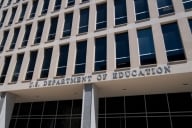You have /5 articles left.
Sign up for a free account or log in.
WASHINGTON -- A brief filed Tuesday with the U.S. Supreme Court seeks to shake up the legal and political calculus of a case that could determine the constitutionality of programs in which colleges consider the race or ethnicity of applicants. In the brief, four Asian-American organizations call on the justices to bar all race-conscious admissions decisions, arguing that race-neutral policies are the only way for Asian-American applicants to get a fair shake.
Much of the discussion of the case has focused on policies that help black and Latino applicants. And the suit that has reached the U.S. Supreme Court was filed on behalf of a white woman, Abigail Fisher, who was rejected by the University of Texas at Austin.
But the new brief, along with one recently filed on behalf of Fisher, say that the policy at Texas and similar policies elsewhere hurt Asian-American applicants, not just white applicants. This view runs counter to the opinion of many Asian-American groups that have consistently backed affirmative action programs such as those in place at Texas.
It is impossible to know how much weight the Asian-American issue will have with the justices. But the briefs have renewed a debate about who benefits -- and who loses -- from race-conscious admissions. While the briefs portray Asian Americans as victims of affirmative action, other Asian-American groups are planning a brief backing affirmative action, and some experts on Asian-American educational trends caution that the new briefs have oversimplified a complicated issue, identifying the wrong culprit and ignoring the benefits some Asian Americans receive from affirmative action. Generally, those Asian-American leaders backing affirmative action stress the significant diversity among Asian-American students in the United States -- including many recent immigrants who are not achieving instant academic success.
The case before the Supreme Court challenges the right of UT-Austin to consider race and ethnicity when it has been able to achieve some levels of diversity in the student body through a race-neutral means: the "10 percent" law that has assured all graduates in the top 10 percent of high schools in the state admission into any public university in the state. The university maintains that it should have the right to use other measures as well, and two lower courts have backed that position. Fisher's lawyers disagree.
One test the Supreme Court has set for race-conscious decisions by public entities is that such efforts must be "narrowly tailored," and the briefs focused on Asian-American applicants appear to suggest that the Texas program cannot meet that test in part because the programs are (in the plaintiff's view) hurting some minority students to help others.
The brief filed Tuesday on behalf of Asian-American groups Tuesday focused less on the Texas admissions policy than on the consideration of race generally in college admissions. "Admission to the nation’s top universities and colleges is a zero-sum proposition. As aspiring applicants capable of graduating from these institutions outnumber available seats, the utilization of race as a 'plus factor' for some inexorably applies race as a 'minus factor' against those on the other side of the equation. Particularly hard-hit are Asian-American students, who demonstrate academic excellence at disproportionately high rates but often find the value of their work discounted on account of either their race, or nebulous criteria alluding to it," says the brief.
It was filed on behalf of the 80-20 National Asian-American Educational Foundation, the National Federation of Indian American Associations, the Indian American Forum for Political Education, the Global Organization of People of Indian Origin and the Louis D. Brandeis Center for Human Rights Under Law. (The latter group focuses on discrimination against Jewish Americans, and the brief argues that today's admissions policies have the same impact on Asian-American applicants as previous generations' policies had on Jewish applicants.)
The brief focuses heavily on research studies such as the work that produced the 2009 book, No Longer Separate, Not Yet Equal: Race and Class in Elite College Admission and Campus Life (Princeton University Press), which argued that -- when controlling for various factors -- one could find the relative "advantage" in admissions of members of different ethnic and racial groups.
The book suggested that private institutions essentially admit black students with SAT scores 310 points below those of comparable white students. And the book argued that Asian-American applicants need SAT scores 140 points higher than those of white students to stand the same chances of admission. The brief also quotes from accounts of guidance counselors and others (including this account in Inside Higher Ed) talking about widely held beliefs in high schools with many Asian-American students that they must have higher academic credentials than all others to gain admission to elite institutions.
The brief filed on behalf of Fisher does focus on Texas policies -- and specifically their impact on Asian-American applicants. Texas has stated that it considers black and Latino students "under-represented" at the university, based in part on their proportions in the state population. And the Fisher brief considers that illegal.
"UT’s differing treatment of Asian Americans and other minorities based on each group’s proportion of Texas’s population illustrates why demographic balancing is constitutionally illegitimate.... UT gives no admissions preference to Asian Americans even though 'the gross number of Hispanic students attending UT exceeds the gross number of Asian-American students attending UT.' This differing treatment of racial minorities based solely on demographics provides clear evidence that UT’s conception of critical mass is not tethered to the 'educational benefits of a diverse student body.' UT has not (and indeed cannot) offer any coherent explanation for why fewer Asian Americans than Hispanics are needed to achieve the educational benefits of diversity."
A footnote in the brief seeks to drive home the point: "Recognizing representational diversity as a compelling state interest might allow universities in racially homogenous states to employ race to the detriment of qualified minority applicants in order to maintain a student body that mirrors the state population. Indeed, that is precisely the problem facing Asian-American students in Texas, as they are 'over-represented' demographically but highly qualified academically."
University of Texas officials are not giving interviews on the briefs. But an affidavit in the case from Kedra Ishop, currently director of admissions at UT-Austin and, at the time she gave the statement, associate director there, suggests that Texas may contest the idea that Asian-American applicants could not benefit from affirmative action at the university.
In the statement, Ishop outlines factors that could be considered in admissions, listing them this way: "the socioeconomic status of the applicant's family and school, whether the applicant is from a single-parent home, whether languages other than English are spoken at the applicant's home, the applicant's family responsibilities and (starting with the fall class of 2005) the applicant's race." These criteria suggest that some Asian-American applicants could in fact receive some assistance on the university's approach to admissions.
Debating the Asian-American Perspective
Much of the reaction to the new brief focused on the wisdom of Asian-American groups taking a stand against the consideration of race.
S.B. Woo, a retired professor of physics at the University of Delaware, and president of the 80-20 group, said he knew that Tuesday's action was a significant step. Nine years ago, when the U.S. Supreme Court last considered the issue of race in admissions, the group considered filing a brief, but opted not to do so. "We didn't know enough then to take a clear stand, but now we do," he said.
In the years since, he said, it has become clear that consideration of race in admissions is not solving the nation's educational problems and "we now realize how much we have been discriminated against."
Four other Asian-American groups -- the Asian Pacific American Legal Center, the Asian American Justice Center, Asian American Institute and Asian Law Caucus -- filed a joint brief backing the University of Texas when the case was considered by the U.S. Court of Appeals for the Fifth Circuit. And these groups are planning to file another brief with the U.S. Supreme Court.
Woo said he realized that those groups had been speaking for Asian Americans generally in the affirmative action debate, but he said that students and families don't agree with them. He said he wasn't bothered that other Asian-American groups would be challenging his positions. "They will be, as we will be, accountable. Let's see how it will play out," he said.
Several experts on Asian Americans in higher education agreed with Woo that many parents and families are frustrated by the college admissions process, and perceive it as hostile. But they questioned whether affirmative action programs really are responsible.
Mitchell J. Chang, professor of higher education, organizational change and Asian-American studies at the University of California at Los Angeles, said that it is true that many Asian Americans "seem to be the ones who have the lowest chances, all things being equal, of getting into the most selective institutions." Chang said that part of the problems is the "hypercompetitive" environment in selective college admissions.
But to the extent that Asian-American applicants are being held to a higher standard, Chang said, that is primarily compared to white students, who aren't benefiting from affirmative action. "There is an issue we have to deal with: Why aren't Asian Americans with the same qualifications getting into the institutions at the same rate as white students? That's the question we have to address."
He said briefs like those filed Tuesday will reinforce the sense that it is other minority students taking slots from Asian Americans, something Chang does not believe to be true. "But that sentiment is out there, and that's where [the brief filed Tuesday] is going to have a real impact."
Robert Teranishi, associate professor of higher education at New York University and author of Asians in the Ivory Tower: Dilemmas of Racial Inequality in American Higher Education (Teachers College Press), said he believed Tuesday's brief was based on "a couple of false assumptions," one of them being that programs for black and Latino students should be a target. Teranishi asked, for example, why those concerned about the admission of Asian Americans to elite colleges -- especially private institutions -- were not focused more on preferences for alumni children. While so called "legacy admits" do include non-white applicants, such preferences overwhelmingly favor white people.
Teranishi also said he was worried by a narrative that diversity efforts help only black and Latino students, and that discussions of diversity should focus on elite institutions. He said that many non-elite institutions do quite a bit to recruit, admit and graduate Asian-American students who come from recent immigrant groups to the United States and who typically do not fare well in traditional admissions. Those programs are vital, he said, but could disappear if Texas loses at the Supreme Court. "I fear we are seeing Asian Americans used as a wedge group, which is really problematic, based on narrow interpretations of what affirmative action is."
Further, he said that he worries that the current focus will distract Asian-American leaders from emerging threats in higher education. For instance, he said that he worried that the current emphasis of many colleges to recruit many more international undergraduates (many of whom are from Asia) was creating a false sense that higher education has "too many Asians." While Teranishi said he was in no way opposed to international recruitment, he said he wanted to know how this emphasis on foreign students (who can pay their own way) was affecting other diversity efforts.
Over all, he said, Asian Americans benefit not from attacking affirmative action, but from "broader inclusion."








